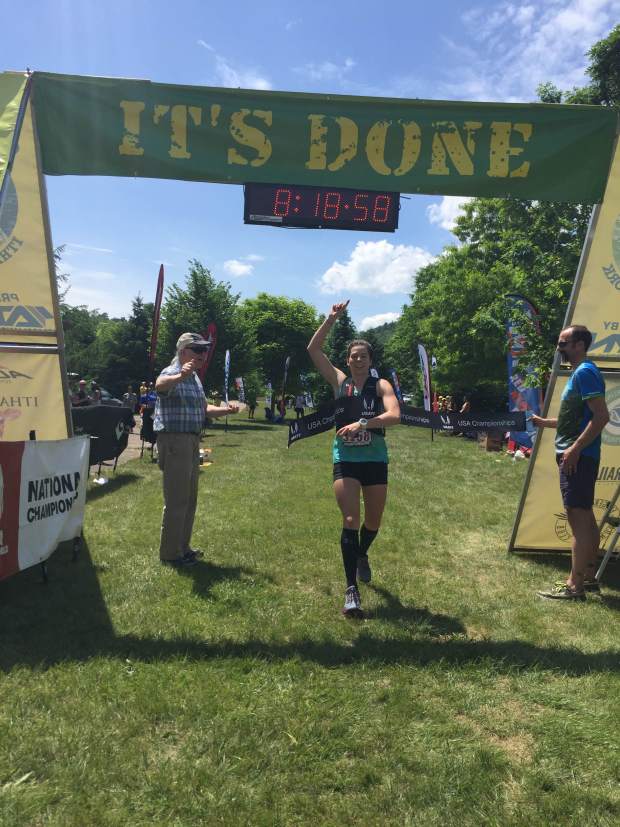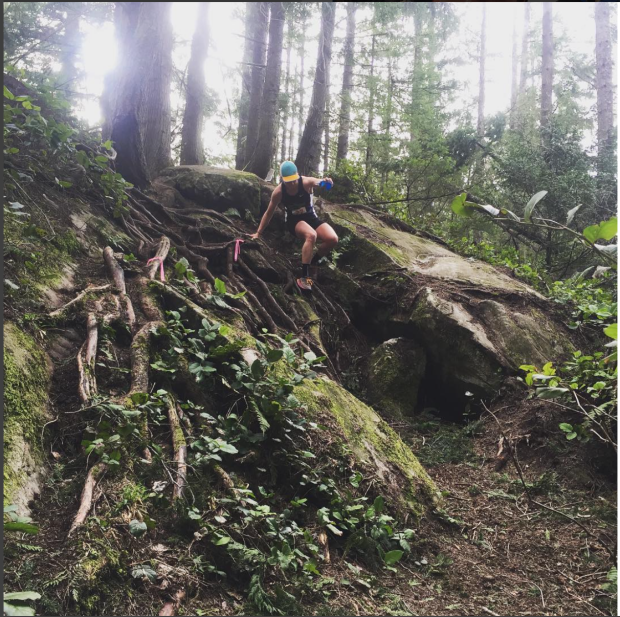
With more than 9,000 feet of elevation gain and an estimated minimum of six to eight hours on course, the Cayuga Trails 50 (a trail running race in Ithaca, N.Y.), leaves many racers questioning the location of their quads and searching for an IV by the finish line. Racers scramble up gorges and single track trails, careen down stone staircases and slosh through creeks as part of the out-and-back 50-mile lollipop loop. For many, the constant change of scenery is welcome break from the monotony of nonstop running.
Elite and experienced trail runners are particularly drawn to the ultra event. After its inaugural race in 2013, it served the next three years as the USA Track and Field (USATF) 50-mile trail championship race. Entrants thereby earned the opportunity to qualify for international competitions if their results warranted.
While many of the top names on the 2016 start list were repeats from previous years, Corrine Malcolm wasn’t one of them. Malcolm, best known as a former member of the US Biathlon women’s team, had only competed in one other trail race longer than 50 k.

This April on her 26th birthday, she completed the Gorge Waterfalls 100k in Columbia River Gorge, Ore. As she put it in a blog post, in the Cayuga Trails 50, she was “a little fish” in a big pond.
“I knew that I could survive the distance after running Gorge 100 k,” Malcolm said in a phone interview. “I feel like ultra running is really similar to nordic skiing in that it really rewards the people who are willing to suffer … It’s going to hurt because you’re running for a long time and so if you’re willing to accept the fact that it’s going to be painful and not be surprised by that, you’re going to be rewarded in your effort. So I knew that even though I was inexperienced competitor, I’m really good at suffering.”
Malcolm did more than just survive and suffer, she succeeded in pulling away from the field and crossed the finish line in first. She completed the 50 miler in 8 hours, 18 minutes, which stood as the second-fastest female time ever recorded in that race. Along with prize money and post-race pie, she also earned a spot on the USATF team trip to the 2016 Trail World Championships in October in Geres, Portugal. Malcolm indicated that this year, USATF will cover most athlete travel and accommodation expenses for Trail World Championships.
“Because I won the national title, I was given some extra funding from USA Track and Field to make the trip feasible … which is cool as a poor graduate student,” Malcolm explained. “I definitely plan to go [to the Trail World Championships]. Biathlon was fun because we got to travel and I haven’t gotten to travel for a race in a really long time. Some I’m totally looking forward to making the big flight across to Euro-land.”
Though Malcolm is a relatively new name to look out for in trail-running competitions (Ed. note: Trail Runner magazine featured her in 2012), she’s a longtime competitor. She ski raced for Montana State University for two years before leaving school to train full-time with Maine Winter Sports Center and focus entirely on biathlon. She qualified for Junior World Championships and European World Championships in 2011 — racing to a sixth at European World Championships — and later that spring, she was nominated to the US Biathlon senior women’s team. She raced for the national team from 2011-2013, but after two years, Malcolm felt the pressure to perform and her performances weren’t lining up.
“That’s how I felt on the national team, even though the coaches were wonderful and my teammates were wonderful, I felt like I was in a fishbowl,” she said.
In her ‘about‘ page of her blog, Malcolm described feeling “fast tracked” upon moving to the Olympic Training Center in Lake Placid, N.Y.
“Unfortunately it was easy to forget how much younger I was [than my teammates], the coaches forgot, I forgot, and eventually it took it’s toll on my health,” she wrote. “I was part of a select group that the 2014 Olympic team would be chosen from, but I was ultimately too sick to compete.”
“I had to perform,” she recalled in the phone interview. “I had to keep up and the finish line just kept moving further and further away. And I don’t feel like that now with running. My level of stress is so much lower.”
Running became Malcolm’s new competitive outlet. She began working with David Roche, a coach, lawyer, Trail Runner columnist, and member of the Nike Trail Elite Team. After skiing for so many years, Malcolm found the switch to having a weekly mileage quota versus hours almost easy, despite also currently working on her master’s degree in biomedical physiology and kinesiology at the Simon Fraser University in Vancouver, British Columbia. She indicated she may even find time to return to coaching–she spent this past winter coaching the Bridger Biathlon Club in Bozeman, Mont.–potentially with a biathlon club in Whistler, Bristish Colombia.
“I had to keep up and the finish line just kept moving further and further away. And I don’t feel like that now with running.” — Corrine Malcolm on her transition from biathlon to ultra trail running
“Being a runner is really sweet because you don’t have to train 20 plus hours a week,” Malcolm said. “And as a graduate student–not that that’s like super time consuming, I’m probably not the best graduate student in that regard, mostly I just read journal articles until my eyes bleed. Then I go for a run and it’s great–I only have to run like 7-15 hours a week..so the time commitment [for running] is really manageable with a job or with school, just because the time commitment isn’t nearly as big for me as it was when I was skiing.”
Being a former skier also helped Malcolm transition to full-time trail running. Though she says she’s had a few “imbalances” she’s had to work on–her right side tends to be tighter than her left–she’s remained injury free, thanks to ski-structured strength, off days and recovery workouts.
“Compared to the trail runners that come from road running, I feel like I can take a hit a little bit more,” she said. “I still do strength a couple times a week — very skier-ish strength. I feel like that protects me in someway from developing an overuse injury. … I think from ski training, I think I’m also really good at eating. I remember going to junior REG camps with Garrott Kuzzy and he’d pull out birthday cake on our long runs. I mean, I did that in northern Maine, too, I’d bring pecan pie on long training runs. So I’m really good at just putting down food consistently.”

During her ultra races, Malcolm generally consumes a packet of gel every 30 minutes and 32 ounces of water every hour. Most of her weekly miles have been in the 40 to 60 range, although she put in an 85-mile week and a 104-mile week in April. The biggest change for Malcolm wasn’t dietary or mileage or hours a week, it was pace.
“Like 9:30-10:00 minute miles are the nordic skier’s jam,” she said. “You know, like 10:00 miles all day long … I’ve had to get used to running my workouts quite a bit quicker than that. Just because my legs were like, whoa, we can run 7:00 minute miles really efficiently? This is crazy.”
Malcolm’s training plan was effective. With her second ultra run behind her, her first ultra win and plenty of trail trekking in store, Malcolm sees running as her new “sustainable hobby.” A sport she finds not only success, but happiness in doing.
“My coach told me the day before [the Cayuga Trails 50], ‘OK, my goal for you is to be the Steph Curry of smiles,’ ” Malcolm explained. “Like that was our goal going into the race was just to smile more than anyone out there, be so happy at every aid station that they insist on giving you caffeine-free gels. So when you have that kind of attitude, you work really hard on being happy the whole time and you don’t think about how bad your quads hurt.”
Gabby Naranja
Gabby Naranja considers herself a true Mainer, having grown up in the northern most part of the state playing hockey and roofing houses with her five brothers. She graduated from Bates College where she ran cross-country, track, and nordic skied. She spent this past winter in Europe and is currently in Montana enjoying all that the U.S. northwest has to offer.



